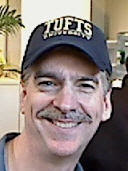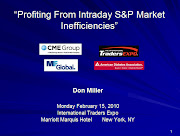This is a good one.
Once there was a well-known trader who went into public exile for 2 1/2 years to -- among other things -- focus his market energies 100% on trading. In doing so, he crafted a renewed and proven comeback mindset effective 1/1/08 with a fictitious equity drawdown to minimize the risk of an actual drawdown.
And the mindset worked incredibly well ... for six months, six days, and about fourteen hours.
Then, he made his first and worst sloppy trade sequence of the year ... right after he restarted his blog.
Wouldn't you know it.
Yup, it happened. I got sloppy on Monday afternoon with respect to size management in a highly volatile market and got caught as the squeezee vs. the squeezor. Now while it's true those of us at the CME who provide market liquidity do get caught from time to time in squeezes, that's not an acceptable excuse. Like I said last week -- and have for the last decade in various forums -- I'll always share the God's honest truth including the good, the bad, and the ugly.
Then, as has often happened during most drawdown phases, the start of the next day started poorly as I was pressing.
But here's where the tide turned. At that point -- in the middle of day two -- I said enough, and went immediately into "EESM" -- "Emergency and Extended Scalp Mode" -- which essentially means, "get size down, and scalp like hell until you get your rhythm back and restore the drawdown". Kind of like a self-imposed trip to the penalty box and shower for a high-sticking major and game misconduct. It includes beginning with a trade-by-trade profitability log on day one, followed by tracking the % comeback day-by-day until 100% is reached.
Now early in my career, it might take a month or more to restore the drawdown. Every successful trader has been there -- and I mean EVERY. But here I sit at 3:15 on Friday afternoon -- a mere 3 days after EESM started -- and I've recovered 53%. [btw, thanks for those last two PM shorts Mr. Bernake ... nice closing trades for the weekend.]
Day 1 of EESM was typical of comeback mode: 24 trades; 21 winners; average ES point gain a tiny 0.40; net take for the day $12K.
Conclusions? Perhaps even despite the best of safeguards, it sometimes takes that one real experience to reinforce intent. The chart still did the trick though as the draw was far, far less than that shown in the fictitious chart (remember, the fictitious draw is meant to be earth-shattering beyond what should ever happen), and history has shown that the comeback will occur ... it's simply a matter of doing everything possible to ensure the timeframe is as short as possible.
It's also a reminder that risk in this business can be minimized, but never eliminated.
Friday, July 11, 2008
Subscribe to:
Post Comments (Atom)
















3 comments:
I guess the trick is making the number real while keeping the circumstances that produce the number ficticious (I think I've had enough practice with the actual circumstances).
I'm thinking of generating a number that is "makeable" over a few days, based on recent performance. Track against it on a daily basis, and when you make it you have to hold it for a few days before you get a new number. For myself, the daily number seems like it will keep my from maximizing a good day, while a monthly number doesn't 'push' me enough.
Not to state the obvious. But if you use your "EESM" mode to recover from your routine trading strategy...why not just make EESM your routine trading strategy??
Hi.
An interesting question. Essentially, I suppose that's the intent of the fictitious draw visualization ... to always be in that focused EESM mode. Yet since we're all human, when that "real" blunder occurs (hopefully few and far between), it's like getting a true wake up call.
One difference for me with EESM though, is taking profits even sooner than "normal" to get the confidence and rhythm back ... sometimes simply buying the bid and selling the ask. Of course with Merc member commissions, such frequent trading is less costly than if someone was paying retail.
Good question though.
Don
Post a Comment